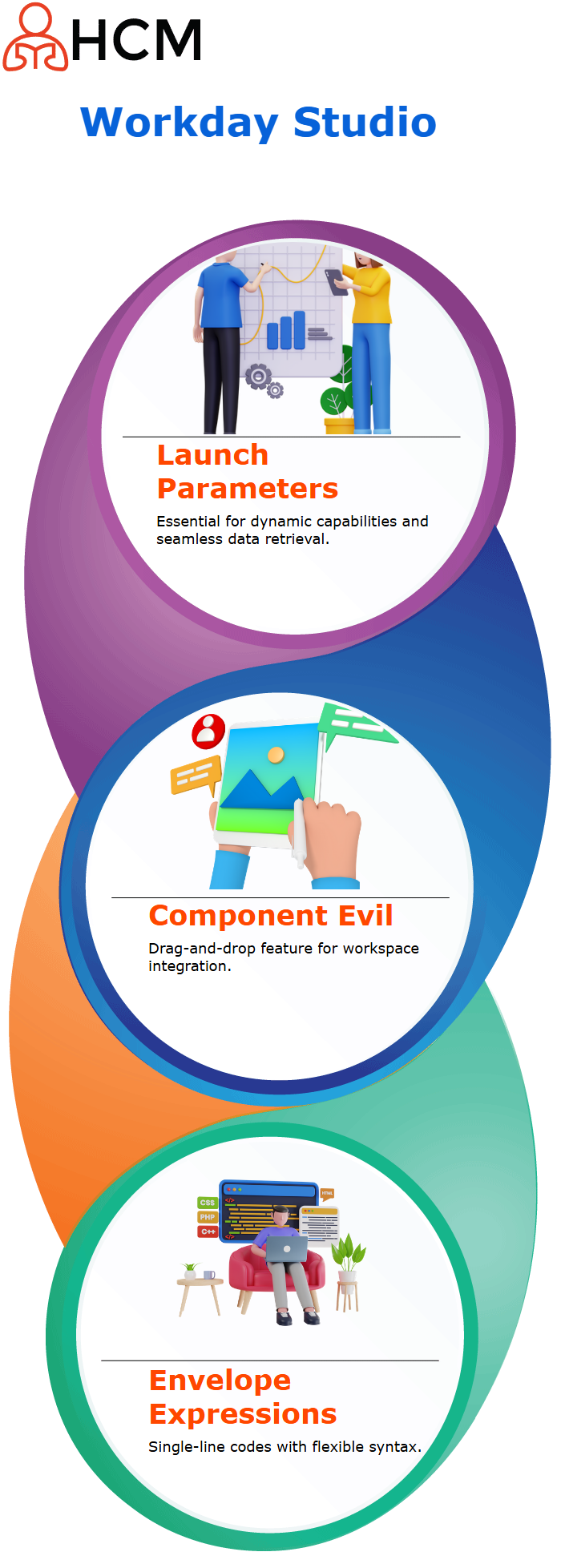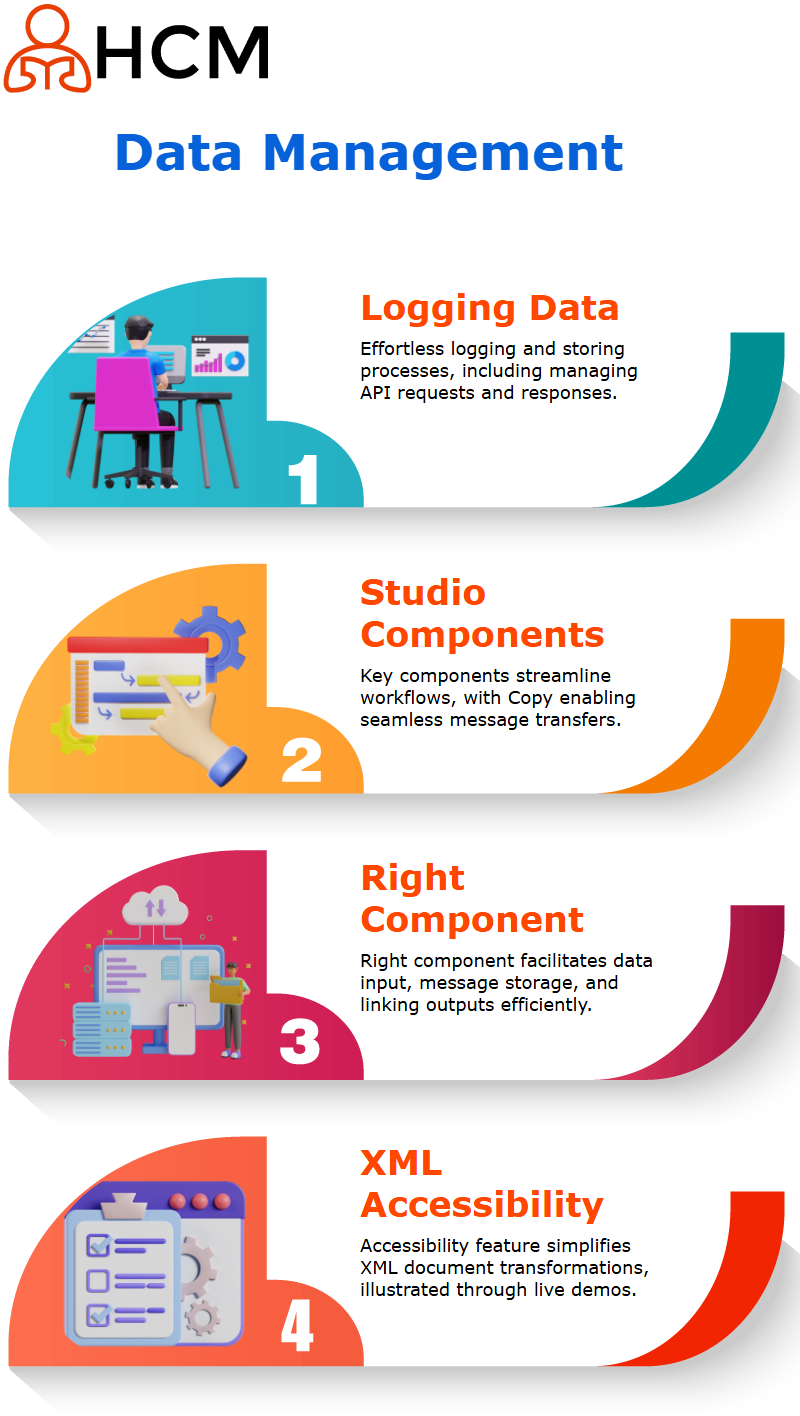Hyderabad’s #1 Choice for Workday Training in Hyderabad {2025}
Workday Studio Course in Hyderabad
Topic Overview
Understanding Workday Studio Components
Workday Studio is an impressive and dynamic tool. Launch parameters play an essential part of its dynamic capabilities; understanding their handling in Workday Studio reveals much about its dynamism.
Fetching launch parameters as variables is where functionality kicks in. Workday Studio presents its second component – “evil.” Simply search “evil,” and it is readily available for drag-and-drop into any workspace.
Workday Studio Expressions provide ample room for creating single-liner codes known as envelope expressions that provide basic syntax open for exploration.
Assign Variables in Workday Studio
Workday Studio makes declaring variables simple. Simply use “props,” and let the helper guide your selection process.
By typing ‘PR” and hitting control-space, Workday Studio reveals options for quick selections; for instance, you could assign variable “date” as property in Workday.
Simple! Simply assign each variable a name like ‘propDate,’ and assign its value. Repeating this process allows you to easily create as many variables as desired.
If you are learning through a Workday Studio Course in Hyderabad, this part becomes second nature with guided examples and practice exercises.
Fetching Launch Parameters with Workday Studio
Fetching launch parameters is an integral component of working within Workday Studio, offering functions like “LP.get” that adapt depending on their type.
My projects utilize ‘LP. getSimpleData’ to retrieve data while configuring settings like time zones.
Workday Studio makes this process seamless; usually working with date parameters like fromDate and to Date with great success and retrieving their values with pinpoint precision.
Common Traps and Practices in Workday Studio
Working on Workday Studio demands close attention to every detail, particularly regarding codes and configurations.
Even minor mistakes could halt deployment so being vigilant with regard to codes is crucial in maintaining its successful operation.
Workday Studio ensures flexibility when setting employee status (‘active’ in my case). Utilising its LP functions and launch parameters makes this an enjoyable experience; each parameter can be tweaked according to project needs.
Joining a Workday Studio Course in Hyderabad can help identify and avoid such common traps early in your learning path.
Workday Studio Log Components
In Workday Studio, ensure log components are positioned accurately so we can capture key data while monitoring integration progress.
Log components enable me to capture this valuable information quickly.
As soon as add a log entry, its content reflects naturally. But in order to enhance it, the key lies in adding meaningful details that add depth.
One example uses Workday Studio text fields to populate variables with additional layers of information relating to integration names or user details.
Importantly, Workday Studio allows us to maintain core messages without manually manipulating logs.

Populating Variables in Workday Studio Logs
Ability to dynamically display variable values makes its use truly revolutionary.
By inserting variables in the text field, ensure that log files contain accurate information.
Error Handling with Workday Studio
Workday Studio boasts an excellent error detection and reporting system. Recently, encountered a ‘Loop detected’ error during integration; using its comprehensive error log feature provided us a roadmap towards resolution.
Configuring attributes and properties requires making sure all required fields are set up accurately to avoid errors that result from missing configurations, but Workday Studio offers detailed logs which make tracing the source of any such issues simpler than ever before.
By taking advantage of Workday Studio Integration Attributes, we can make our workday Studio configuration even faster than before!
Workday Studio Course in Hyderabad, these real-world error scenarios will make much more sense as you progress.
Utilizing Workday Studio Integration Attributes
Workday Studio gives us the ability to set integration attributes and maps directly on connectors, providing more precise integrations that meet specific requirements.
These settings help tailor integrations specifically towards our requirements – for instance by adding attributes like ‘Integration Name’ or “Map Service” which help add structure and clarity throughout the integration process.
Setting them up in Workday Studio is both intuitive and efficient, which demonstrates their value as essential tools in creating flexible processes while adhering to best practices.

Workday Studio and the Importance of Attributes
Attributes play a pivotal role here – helping avoid hard coding while increasing flexibility while adhering to best practices.
Imagine working with an API from a vendor. It has three components – URL, user ID and password.
Hard coding these details in might appear convenient at first, but consider this: when password policies require changes every 90 days? In such an instance, Workday Studio needs to be opened again so variables are updated before redeployment takes place again.
Workday Studio allows for an alternative approach using attributes and maps, where attributes allow for declaring dynamic values like user ID, password and URL that can easily be modified later without changing code.
As part of an integration deployment process, for instance, when specifying attributes as required for launch such as user ID and password you can ensure they will be configured prior to running the integration.
Workday Studio makes creating integration attributes straightforward. For example, declaring user ID as text and marking it ‘required for launch.’
You can also enable password displays as secure masked fields for easy management.
As soon as these attributes have been saved and deployed, Workday Studio ensures that integrations won’t run unless all necessary values have been configured.
This feature can be especially beneficial when values, like passwords, require regular updating.
Instead of altering code directly, simply update integration attributes through system configuration – Workday Studio handles everything else seamlessly for easier ongoing maintenance of integrations.
Completing a Workday Studio Course in Hyderabad provides in-depth guidance on these best practices and techniques.
Fetching Attributes in Workday Studio
Fetching attributes is made easier within Workday Studio through specific syntax. By accessing functions like “incess. get Attribute,” values such as user IDs, passwords or URLs directly from integration systems like Workday can be easily extracted as attribute values retrieved using Workday.
Workday Studio makes integration dynamic by eliminating hard coding; therefore, retaining its key principles.
Maps provide another layer of flexibility, as they enable transformation values dynamically according to conditions.
If an integration requires changing male to male or female to female, maps provide the solution without hardcoding logic directly into scripts.
Workday Studio maps offer an effective solution when requirements change; for instance, when vendors request that female be represented as SE rather than F.
They allow you to update this mapping without changing code, keeping integrations clean and adaptable.
A Workday Studio Course in Hyderabad often includes case studies to demonstrate how mapping is done dynamically.
This hands-on experience solidifies your understanding and prepares you for real integration scenarios.

Integration Maps in Workday Studio
Let me demonstrate how integration maps work within Workday Studio. First, name and set an integration map to type text for its output type as well as name gender as input type for testing purposes.
That’s how we can start learning through a Workday Studio course in Hyderabad.
Magic of Reverse Lookups in Workday Studio
Workday Studio makes reverse lookups incredibly interesting; these special lookups act like the opposite of regular map lookups to help create flexible integrations easily and without fuss.
Learning this concept in a Workday Studio course in Hyderabad helps clarify its practical use.
Exploring Web Services with Workday Studio
Web services play an essential part of Workday Studio when it comes to fetching and loading data.
For example, its “get” operation enables users to retrieve specific suppliers or employees based on criteria like ID or reference ID.
A Workday Studio course in Hyderabad explains how these operations interact within real integrations.
How to Test Web Services in Workday Studio
Test web services with Workday Studio by understanding their schemas. Navigating to the appropriate tab and choosing options such as ‘Add Latest Web Services” can give your insight into all available functional areas.
This was clearly explained in a Workday Studio course in Hyderabad, especially around HR services.
Connecting Tenants in Workday Studio
Applications and instances within the Workday cloud are interlinked, and Workday Studio establishes connections with particular tenants.
In a Workday Studio course in Hyderabad, we can learn how tenant-specific deployment affects integration success.

Workday Studio's Web Service Tester
Workday Studio’s coolest tools – its Web Service Tester. This inbuilt feature makes gathering and verifying data super straightforward and straightforward.
Workday Studio makes it simple and quick to manage employee details in one central place.
From gathering all workers details or zeroing in on one in particular, Workday Studio course in Hyderabad can help understand every test case scenario.
Fetch Worker Data by ID in Workday Studio
First you select “Get Worker by ID,” input your worker ID number, and hit finish; this request then quickly sends to and obtains all relevant data about said worker.
By practicing this hands-on during a Workday Studio course in Hyderabad, which made testing seamless.
Exploring Web Service Builder in Workday Studio
Workday Studio offers the Web Service Builder as another useful feature to test and configure requests easily.
From collecting all worker data to isolating specific details for one worker ID, this tool makes creating customized requests effortless.
This method during my Workday Studio course in Hyderabad, which included practical examples.
Workday Studio for Secure Data Retrieval
One thing I appreciate about Workday Studio is how smoothly and securely it handles retrieving data.
From fetching through Get requests or loading via Import or Submit, all these tasks run seamlessly within this tool and from Workday Studio Course in Hyderabad.

Logging and Storing Data with Workday Studio
Workday Studio makes logging messages and storing files an effortless process, whether working with web services or not.
For web services in particular, however, this might involve configuring both request and response components of their API calls to manage requests/responses appropriately.
A Workday Studio course in Hyderabad teaches best practices in setting up these flows efficiently.
Understanding Workday Studio Components
Here are some important steps, sharing insights gleaned from firsthand experience. Components in Workday Studio play an instrumental role.
For instance, using Copy to send messages or processes back and forth.
The Workday Studio course in Hyderabad offered deep insight into each component’s real use.
Utilizing the Right Component in Workday Studio
Utilize Workday Studio’s Right component is something truly fascinating; whether you need somewhere to input text or messages, or want an alternative option when searching for their appropriate place on a page – all is covered here!
By the Workday Studio course in Hyderabad, we can learn how to link output from this to storage or file components properly.
Decoding Accessibility in Workday Studio
Accessibility is another impressive feature in Workday Studio that makes for efficient XML transformations.
By using Accessibility to convert existing XML documents to another form easily and effortlessly.
This was illustrated through live demos in a Workday Studio course in Hyderabad, using real XML structures.
Leveraging Workday Studio for Request and Response
Workday Studio excels at handling both outbound and inbound integrations seamlessly, whether that means sending requests directly to web services and then receiving their responses.
Understanding when to use “Right” or “Store” was emphasized heavily in the Workday Studio course in Hyderabad, particularly for request/response flow control.

Inbound Integrations Made Simple with Workday Studio
Workday Studio ensures these processes run efficiently and seamlessly. For example, loading data using “Put” or fetching with “Get” becomes straightforward.
A Workday Studio course in Hyderabad explained how to chain these components for robust inbound integration.
Managing Location Data in Workday Studio
Workday Studio makes managing location data an efficient process. From retrieving locations to adding or editing existing entries, its intuitive interface provides smooth management.
Followed each of these steps while enrolled in a Workday Studio course in Hyderabad, including validations for XML inputs.
Getting Started with Workday Studio Integration
Utilising Workday Studio makes integration tasks simpler since there’s no need to establish full contact structures between components of an integration.
We practiced this hands-on in a Workday Studio course in Hyderabad, where minimizing data complexity was emphasized.
Understanding Workday Studio's Unique Features
Workday Studio makes clear when creating a location online that specifying its effective date is unnecessary; we realized this after accidentally including one and being alerted to a service error.
Eliminating Duplicate Entries in Workday Studio
Workday Studio stands out as an outstanding solution when it comes to eliminating duplicate entries.
Its handling of unique IDs to prevent overlap was a specific topic in the Workday Studio course in Hyderabad, shown through simulated test data.
Master the Workday Studio Builder
Once it comes time for implementation, Workday Studio’s builder tool becomes your ultimate ally in terms of smooth operation.
The drag-and-drop interface and deployment tools were thoroughly can learn from Workday Studio course in Hyderabad.


Vishwak
I write because the fight to learn is just as crucial as the knowledge acquired; every click, every mistake, every little success.
